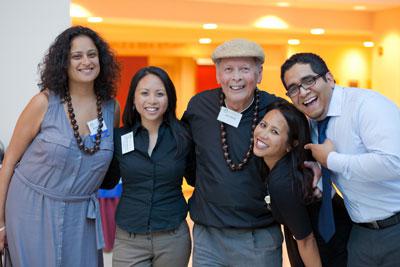
No, I did not just return from a tropical Hawaiian vacation. Rather, the National Coalition for Asian Pacific American Community Development (CAPACD) conference, where each speaker received a lei, bringing some AAPI culture to Washington D.C. for the three-day event.
The theme, “Building Equity, Building Power: Redefining Community Development,” brought together a spectrum of speakers and participants discussing topics including innovations in community development, the importance of political power for AAPI communities (especially given the state of poverty and community organizing), and comprehensive immigration reform.
Among them were longtime Shelterforce friends and interviewees Rep. Keith Ellison (D-MN), who told us all about his tireless fight for pushing legislation in the House that will benefit communities of color, and HUD Secretary Shaun Donovan who discussed the Obama administration’s commitment to AAPI populations through the “Building Ladders to Opportunity” White House initiative and other projects.
In reflecting on my experience, a few themes emerged:
1. The Obama Administration has a clear commitment to AAPI communities. The “Building Ladders to Opportunity” initiative, and the White House initiative on Asian Americans and Pacific Islanders—we heard from initiative leaders Sefa Aina and Kiran Ahuja—are just two of the many examples of work being done that specifically focuses on AAPI populations.
2. Good data is important, but narratives and “telling your story” are more important. Limited census categories and flaws in the American Community Survey prevent accurate tracking of all of the ethnicities that comprise AAPI. Good data is necessary to get an accurate picture, but the stories that come from those communities are important when organizing and engaging the political electorate in the future.
3. Political power and an engaged electorate are crucial. Without a political voice, there are extreme limitations placed on the reach of well-meaning, hardworking community organizations trying to advocate for communities of color. CAPACD partnered with a number of organizations leading up to the 2012 election to ensure that the needs of AAPI communities were being addressed in the campaigns and that the community itself was actively engaged and utilizing its political voice. According to the report Blanca Flor Guillen-Woods of Latino Decisions gave, there were significant victories won by CAPACD and others in cultivating a more engaged AAPI electorate. Well done, CAPACD!
4.The state of affordable housing is bleak, but there are opportunities for success. The workshop on affordable housing development started off, well, pretty sad. Listening to the stats of where we are and where we need to be to revitalize communities would make even the most optimistic in the room want to run and hide. But, there are opportunities, as Shiela Crowley of the National Low Income Housing Coalition explained. New Markets Tax Credits might be extended in the near future (we’ll keep an eye on that for you) and the coalition is leading the push to make the Housing Trust Fund permanent (you can help by signing the petition on their website). A workshop on fair housing and lending also provided some needed optimism, and community organizations are doing an increasingly better job of documenting housing discrimination and pushing for equal rights to all communities. For example, National Fair Housing Alliance has some great advertisements in an array of languages to educate people on their housing rights.
5. The community development field is changing. A lot. Community organizations and practitioners have to be prepared to do their work in an ever-changing environment with different financing structures, funding cuts, and concerns about the capacity and scale of community work moving forward. This was particularly interesting to me because Shelterforce’s upcoming issue is about the CDC model: If it is still effective and what it will look like, if it’s still around, in the future. As someone who knew very little about the needs and work of AAPI communities prior to the conference, I feel educated, inspired, and motivated to see that these communities are advocated for and included in the important discussions that Shelterforce has hosted for nearly 40 years.
This is just the tip of what was discussed in the more than 30 workshops. There were conversations on fair housing and lending led by Debby Goldberg; trends and policies surrounding affordable housing development led by Sheila Crowley; opportunities and challenges for communities of color with respect to federal policy advocacy with Janis Bowdler of NCLR and Maya Rockeymoore of Global Policy Solutions; and a VIP luncheon on innovations in community development which was led by Kimberly Latimer-Nelligan of the Low Income Investment Fund.
Latimer-Nelligan explored “Investing in What Works for America’s Communities” (check out Joe Kriesberg’s critique of the report on Rooflines) and was joined by Myrna Melgar of the Mission Economic Development Agency, who stressed the importance of narratives and stories that build on data, not the other way around.
Okay, small confession, everyone was invited to attend the luncheon, but I still like the sound of VIP!
There’s more on the way from this community. Be on the look out for CAPACD’s AAPI Poverty Report, which we’ll have coverage of after it’s released at the end of the month and post-conference conversations, photos, and more are available on the CAPACD website.
(Photo by Les Talusan)





CAPACD is most fun, most thoughtful, and most exciting group that FACE in Hawaii works with!
Even sorrier that I missed the confernence this year!